|
Hello !
As summer begins to wind down, we begin to reflect on all of the
wonderful trail stewardship projects and good times we’ve had this summer. From
the foggiest and windiest days, to the calm and blue, we’ve enjoyed it all with
you.
In this issue, we review our two weeks of American Hiking Society
Volunteer Vacations, advertise our wonderful trail stewardship internships, and
put the spotlight on one of our beloved sites.
As Karl the Fog begins to clear, we look forward to some of the
sunniest days in our parks, and to seeing all of you at our programs!
In This Issue
Last Month: Back to Back Weeks of American Hiking Society!
About the Internship
Edible vs. Poisonous Plants
Park Spotlight: Lands End
Volunteer Vacations with the American Hiking Society
This past month, we had back-to-back exciting
weeks of volunteering in our Golden Gate National Parks. Groups of eight
volunteers from the American Hiking Society traveled from far and wide to work
on the trails with us for a week at a time. Our volunteers camped for the week
in Kent Canyon and spent all of their time together, bonding over dinner around
the campfire each night. We were able to tackle a variety of fun and
challenging projects over the course of each week.
Each week, we started by working for two days at
Battery Townsley, enjoying outstanding vistas of the Marin Headlands. We
installed check steps along the trail as a way to repair rutting along the
trail caused by erosion.
Check steps are 6 to 8-foot-long wooden posts,
called peelers, which are anchored and buried across the trail before the trail
is resurfaced. Once installed, the steps work by diverting the flow of water
off the trail and catching dirt and rock so the trail does not develop ruts.
This multi-step project, called Check and Fill, involves digging small trenches
to lay the peelers into the ground, before drilling them into the ground and
resurfacing the trail with drain rock and a layer of shale.
After a fun couple of days at Battery Townsley,
we spent a day hiking and brushing along the Sun Trail, located along Panoramic
Highway in the Marin Headlands. We enjoyed getting to work so close to the
towering redwoods of Muir Woods National Monument.
We concluded each week by helping to install new
fences in our park. During our first week, we worked to repair the fence lining
the coast behind Battery Godfrey, looking out over the Golden Gate as we
worked. We wrapped up our second week extending the split-rail fence along the
Upper Tennessee Valley Trail.
We’re incredibly lucky and grateful to get to
work with such fun and enthusiastic volunteers!
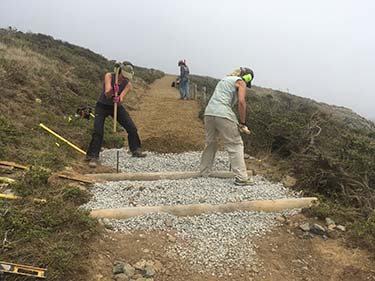
|
| AHS
volunteers install check steps along the Coastal Trail at Battery Townsley (Jaclyn Lim, 2017) |
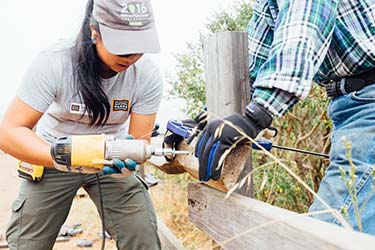
|
| Jaclyn
Lim assembles a split-rail fence on the Tennessee Valley Trail with the
assistance of a volunteer (Matthew Bennett, 2017) |

|
| Volunteers dig deep to place new fence posts on the Tennessee Valley Trail (Matthew Bennett, 2017) |
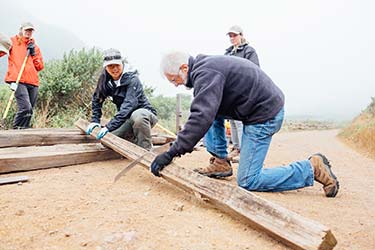
|
| Jaclyn
Lim helps a volunteer cut new fence posts to size (Matthew Bennett, 2017) |
Interning with the Golden Gate National Parks: Trail Interns
Those of you who have volunteered with us have
worked with the Trail Interns as they assist the staff in leading projects.
This internship is a great opportunity to be exposed to the inner workings of a
national park. Along the way, interns acquire many skills (including how to use
power tools and other cool equipment)—while working outdoors in beautiful
places around the Golden Gate National Parks.
There are two types of internships available: 1)
Trail Stewardship, and 2) Trail Construction and Maintenance. Each is 6 months
in duration and involves a great deal of manual labor.
Trail
Stewardship interns are responsible for leading volunteer programs on our
trails. They supervise and work alongside volunteers of all ages and abilities.
Our volunteer projects involve a myriad of trail maintenance tasks, such as
repairing and replacing fences, erosion control through the installation of
check steps, and cutting back vegetation to keep our trails clear and
accessible.
They also give interpretive talks about the
history of the project site and create other informative material about the
parks and their projects (like this newsletter!). When they’re not working with
volunteers, they perform maintenance tasks throughout the Golden Gate National
Recreation Area.
Trail
Construction and Maintenance interns divide their time between construction
and maintenance projects. For three months, they work alongside National Park
Service staff, completing large-scale construction projects. For the remaining three
months, they perform trail maintenance tasks under the supervision of a Park Service
crew leader. These projects are essential in maintaining the beautiful trails
we have throughout our park.
This year’s ongoing construction project has
been the re-creation of the trail at Hawk Hill, transforming it into an
accessible trail for everyone. Staff and interns have put in countless hours
reshaping the terrain, building retaining walls, installing new staircases, and
resurfacing the trail. Built to exacting standards, this trail will be
wheelchair-friendly and provide visitors of all walks of life panoramic views
of San Francisco, the Golden Gate Bridge and the Marin Headlands, while also
affording birdwatchers a primo vantage point for the area’s birds of prey.
At the end of the internship, interns give a
short presentation about their experience and the work they accomplished. Many
of the current NPS staff started out as interns, so this internship is a great
way to get your foot in the door if you want to work for the National Park
Service in the future!
Here are the links to the internships!
Stewardship Internship
Construction and Maintenance Internship
Park location: Parkwide
EDIBLE VS POISONOUS PLANTS
There are many beautiful and interesting plants that can be found
throughout the Golden Gate National Parks. Some are not only pretty, but edible
too!
These edible plants include:
Wild blackberries (Rubus armeniacus) Blackberries are delicious but plucking this
succulent fruit comes at a cost. Its stems and leaves have small thorns that
can prick your fingers and get caught on your clothes.
Himalayan blackberry, the type of blackberry most commonly found
in the parks, is a non-native species, so don’t feel bad picking them—just be
careful not to spread them. This plant is often confused with a notable
poisonous plant in our park: poison oak. The key differences are the thorns
found on the vines of the blackberry plants, in addition to the telltale fruit.
The leaves of blackberry plants are more jagged, and not as shiny as poison
oak.
Nasturtium (Nasturtium
tropaeolum) This non-native species features vibrant orange flowers often used
in salads. They have a somewhat spicy taste. They are sure to make any boring
bowl of greens pop.
Fennel (Foeniculum
vulgare) Another non-native
species, fennel tastes like anise or licorice. It grows in tall green stalks
that eventually flower into small bunches of yellow flowers (somewhat
resembling poison hemlock and cow parsnip).
Miner’s Lettuce (Claytonia perfolita) Named because it was eaten by the early 49ers
flooding into California during the Gold Rush, this plant is a source of
vitamin C and prevents scurvy. It looks and tastes like lettuce. All parts of
the plant are edible.
Wild Mustard (Brassica
nigra) Harvested for its seeds, this plant is also not native to the region.
It can be found flourishing along trails and on the sides of roads. It has
little yellow bunches of flowers surrounding its seed pods. Its seeds, when
ground up and combined with other ingredients, make up the popular condiment.
On the other hand, some plants can be harmful and even deadly if
consumed! Watch out, and don’t mix these up with our edible plants!
These poisonous plants include:
Calla Lilies (Zantadeschia
aethiopica) These attractive
white plants, which are not technically true lilies, contain oxalic acid which
can be deadly if ingested by a baby or a pet—and can cause extreme nausea if
consumed by an adult. The white part that appears to be a flower is actually a
modified leaf called a spathe, which gives these plants their lily-esque
appearance.
Poison Oak (Toxicodendron
diversilobum) This plant is
harmful to the touch! Poison oak contains the oil urushiol, also found in
poison ivy and poison sumac. The good news is poison oak is found exclusively
in California. The bad news is that it’s everywhere. It is structured in
reddish-green leaflets of 3.
Poison oak is often mixed up with blackberries, although the
leaves of poison oak are shinier and their vines do not have thorns. We have a
series of catchphrases to remind you to be wary of this pesky, widespread
plant. Remember: “If it’s hairy, it’s a berry. If it’s shiny, watch your
hiney.” And: “Groups of three, don’t touch me.”
Cotoneaster (Cotoneaster
pannosus) This plant has bright red berries that scream
“pick me” but don’t be fooled. These berries are listed
as Level 4 toxicity by the California Poison Control Center. All parts of this
plant contain cyanogenic glycosides which convert to cyanide during digestion. Although
an adult would have to consume a large amount to experience harmful symptoms, the
ingestion of any part of the cotoneaster affects all the major organs so it is
best to stay away!
DISCLAIMER:
As always, be 100% sure about the ID before ingesting any plant grown in the
wild!
Golden Gate Spotlight: Lands End
You may be familiar with the enchanting tip of
San Francisco, Lands End. Known for its spectacular views of the Golden Gate
Bridge and its many attractions, it is one of the most popular sites in our
parks.
A notable attraction at Lands End is the ruins of
the Sutro Baths. The Baths were constructed in 1896 by Adolph Sutro, former
mayor of San Francisco. Once the world’s largest public bath house, the Sutro
Baths could accommodate around 10,000 patrons and held almost 2 million gallons
of water. The Baths also contained a museum, amphitheater, and ice skating
rink.
The cost of maintaining Sutro
Baths proved too steep and eventually the management decided to close the
facility. In 1966, soon after their closing, a fire destroyed the buildings
while they were being deconstructed. The remnants of the foundation of the
Baths and the existing Cliff House restaurant serve as reminders of a different
era.
At the tip of Lands End, overlooking the Bay, is
a Labyrinth originally created by Eduardo Aguilera in 2004 as homage to “Peace,
Love and Enlightenment.” Because it was privately constructed, the labyrinth is
not officially recognized as an affiliated feature of the park and there are no
park signs leading to it. However, if you follow directions to Mile Rock Beach,
you will probably stumble upon it.
Mile Rock, named due to its location one mile
south of the main shipping channel leading into San Francisco Bay, is situated in
an ideal location for a lighthouse. The lighthouse atop Mile Rock was erected
in 1906 after a series of catastrophic shipwrecks caused by limited visibility
in San Francisco’s infamous fog. The eponymous Mile Rock Beach is a bit of a
trek down, but this rocky beach is well worth it for the view! On a clear day
you can see straight across the Bay to the Marin Headlands and spot Point
Bonita Lighthouse.
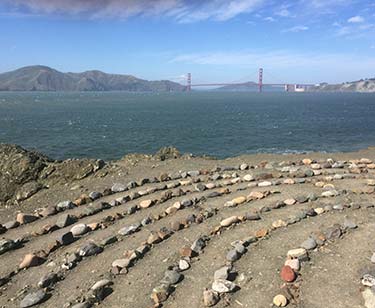
|
| Part
of the Labyrinth overlooking the Golden Gate Bridge (Helena Trifillis) |
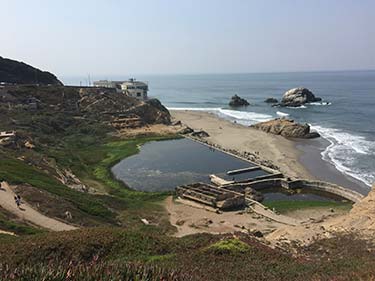
|
| View
of the Sutro Baths ruins and Cliff House restaurant (Patrick Murphy) |
Thanks to everyone who came out to volunteer with the crew last month! We hope to see many new and familiar faces at our October drop-in program. Try to stay cool this fall and enjoy the summery weather!
All the very best and happy trails,
Katie, Jaclyn, Helena, and Patrick
kteschler@parksconservancy.org
|